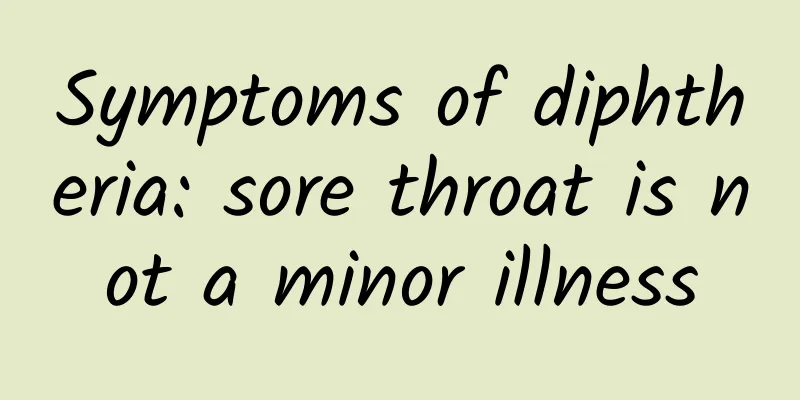Symptoms of diphtheria: sore throat is not a minor illness

|
Diphtheria is a respiratory infection that causes sore throat and ulcers. Diphtheria is caused by viral infection. Severe toxic pharyngeal diphtheria can cause arrhythmia in patients, so it must be treated in time. 1. Symptoms The incubation period of clinical manifestations is 1 to 7 days, usually 2 to 4 days. According to the location of the pseudomembrane and the severity of the poisoning symptoms, it is divided into the following types: 1. Pharyngeal diphtheria is the most common It accounts for about 80% of the cases. (1) Pharyngeal diphtheria without pseudomembrane When diphtheria is prevalent, some patients only have upper respiratory tract symptoms such as sore throat, and the systemic poisoning symptoms are relatively mild. There was only mild inflammation of the pharynx. Tonsils may be enlarged, but there is no pseudomembrane formation, or only a small amount of fibrinous exudate, and bacterial culture is positive. Such patients are prone to misdiagnosis and missed diagnosis. (2) Localized pharyngeal diphtheria The pseudomembrane is limited to the palatine arch, uvula, etc., and the symptoms are mild. The pseudomembrane is limited to one or both tonsils. The onset is slow, and the subjective symptoms include mild to moderate fever, general malaise, fatigue, loss of appetite and mild sore throat. The tonsils are congested and slightly swollen, and the pseudomembranes are initially dot-like and then fuse into sheets. The submandibular lymph nodes may be swollen and slightly painful. (3) Toxic diphtheria It is mainly transformed from localized and disseminated types. Most of them are accompanied by mixed infections. If not treated promptly, the mortality rate is extremely high. Symptoms of this type: the pseudomembrane is mostly black due to bleeding, the tonsils and pharynx are highly swollen, blocking the pharyngeal opening, or there is necrosis and ulceration, with a special corrupt odor. The cervical lymph nodes are swollen and the surrounding soft tissues are edematous, resulting in a thickening of the neck (cow neck). The symptoms of systemic poisoning are severe, including high fever, shortness of breath, cyanosis of lips, thin and rapid pulse, and arrhythmia. (4). Disseminated pharyngeal diphtheria The pseudomembrane extends from the tonsils to the uvula, soft palate, posterior pharyngeal wall, nasopharynx or larynx. The pseudomembrane is grayish white or yellowish white, with clear boundaries and severe redness and swelling in the surrounding tissues. The tonsils on both sides are swollen and even block the pharynx, causing difficulty in breathing. The lymph nodes in the neck are swollen and there is edema around them. Symptoms of this type: severe systemic poisoning symptoms, including high fever, fatigue, anorexia, sore throat, etc.; severe cases can cause circulatory failure. 2. Nasal diphtheria This type is relatively rare and is more common in infants and young children. The systemic symptoms are mild or absent, with nasal congestion, serous and bloody nasal discharge, epidermal exfoliation or shallow ulcers around the nostrils, and white pseudomembrane in the nasal vestibule. 3. Laryngeal diphtheria Laryngeal diphtheria accounts for about 20%. A few are primary, and about 3/4 are caused by pharyngeal diphtheria spreading downward. In primary laryngeal diphtheria, the systemic poisoning symptoms are not serious because of the low absorption of toxins. Secondary laryngeal diphtheria often occurs on the basis of pharyngeal diphtheria, accompanied by the clinical manifestations of laryngeal diphtheria and severe systemic poisoning symptoms. However, in a few cases, the pseudomembrane extends to the trachea and bronchi, causing varying degrees of obstruction. Symptoms include: rough dry cough, hoarseness or even loss of voice, and rapid breathing. In severe cases, cyanosis may occur and the patient may die from suffocation. 4. Diphtheria in other parts of the body It can invade the conjunctiva of the eyes, ears, vulva, umbilical cord of newborns and skin injuries, producing pseudomembranes and purulent secretions. Diphtheria of the eyes, ears, and genitals is mostly secondary. Cutaneous diphtheria is more common in tropical regions. The course of the disease is long, and the skin lesions often do not heal for a long time. Melanin deposition may occur after healing. Symptoms of this type: systemic poisoning symptoms, but peripheral nerve paralysis may occur. |
<<: What to eat to get better quickly from back pain
>>: What disease is it that causes coughing up white foamy sputum? I suspect it is this
Recommend
Symptoms of lacunar infarction
Lacunar infarction is a relatively common disease...
What is the best season to drink Chinese medicine?
People often say that bitter medicine is good for...
What causes finger joint pain?
In our lives, some friends will experience finger...
Cervical epithelial neoplasia
Cervical epithelial neoplasia is a common disease...
Can anxiety disorder heal itself?
Anxiety disorder has become a very common disease...
What is the reason for hard lumps and pus in the ears?
If there is a hard lump and pus is oozing from th...
How walnuts can enlarge breasts, dietary methods for breast enlargement
Having firm breasts is the goal of every woman, w...
When to take ovulation-stimulating Chinese medicine
Ovulation-inducing Chinese medicine should be tak...
Black mole on back
Moles are benign lesions caused by local pigmenta...
Head acupoint massage technique
Tui Na in Chinese medicine is a traditional massa...
Will overusing your brain cause hair loss?
Overuse of the brain is also a cause of hair loss...
Hot palms and soles
Many people are more concerned about the common c...
What are the medicinal values of red peony root?
I believe many people don’t know much about red p...
Clinical manifestations of nerve root adhesions
There are many reasons for nerve root adhesion. T...
Chinese medicine compatibility table
The way of combining Chinese medicine is very cri...









